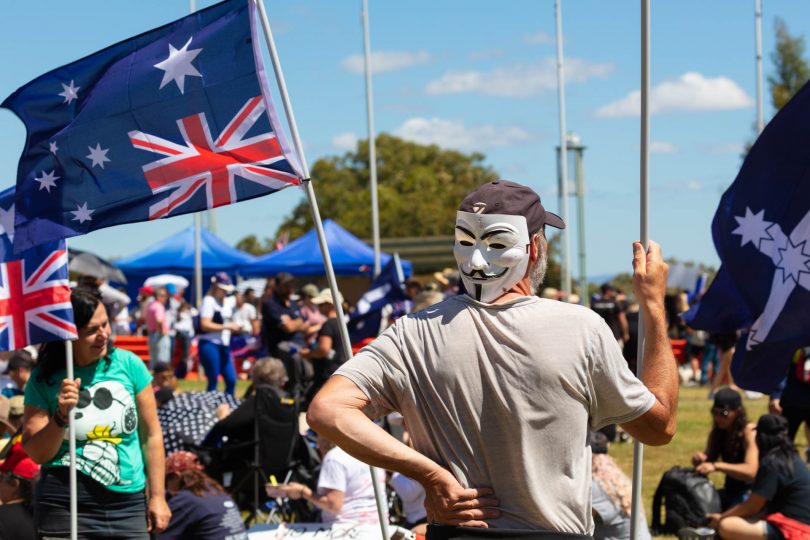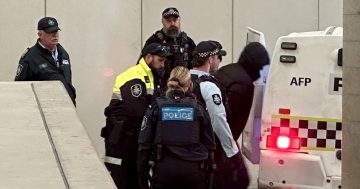
Freedom Convoy to Canberra protest march to APH. Photo: Thomas Lucraft.
Over recent weeks, far-right anti-vax protests have cropped up in Canada, Britain, France and New Zealand. But never have these protests come to a city with a higher vaccination rate than Canberra, where unvaccinated adults are as rare as UFO sightings.
They have a right to peacefully protest, but those of us who believe in science also have a right to point out that vaccines save lives and conspiracy theories can kill. Since the Morrison Government belatedly began rolling out COVID vaccines in Australia, these free vaccines have protected thousands of Australians from hospitalisation and death. COVID vaccines work. Ivermectin, hydroxychloroquine and Vitamin C do not.
The anti-vax protesters aren’t just wrong about the science; they’re also a risk to democracy. As media commentator Van Badham has pointed out, these groups should be judged not by their relatively small numbers but by the damage they’re willing to do. Ironically, the people who claim to be saving democracy are its biggest threat.
The violent anti-lockdown protests in Melbourne, the attack on the US Capitol on 6 January last year and the global so-called freedom protests have brought together a dangerous brew of conspiracy theories. Today, 15 per cent of Americans agree with the central false tenet of QAnon: that the government and other entities are controlled by Satan-worshipping paedophiles running a child sex trafficking ring.
The Melbourne anti-lockdown protesters have waved swastikas and nooses and welcomed anti-Semites. Some of the Canberra protesters waved Ustaše fascist flags and Confederate flags. According to Australian Federal Police commissioner Reece Kershaw, one protestor was arrested with a loaded gun and an internal map of Parliament House.
The Canberra protests attracted support from senators Pauline Hanson, Alex Antic and Gerard Rennick. Like Greens Senator Lidia Thorpe, with her support for those who vandalised the Museum of Australian Democracy, these extreme senators seem not to realise they’re playing with fire.
The protesters didn’t seem to care who they were hurting. When the vandalism of fences at Exhibition Park forced the closure of the Lifeline Bookfair, they shut down a charity event that helps people with mental health challenges. (Sidenote: if you haven’t yet made a donation to Lifeline, they could still really use your support.)
Many Canberrans turned the other cheek, putting up with abuse in the streets and shops. At BentSpoke in Braddon, Richard Watkins and his staff behaved with calm decency when a protester threw a glass at the bar.
The Australian Federal Police moved the protestors on from the National Library lawns with minimal conflict and then did the same again at Exhibition Park a few days later.
The protestors wrapped themselves in multiple flags, but the one that struck me most was their attempt to co-opt the Eureka legend.
In one sense, there’s nothing new in this. Barely had the shooting stopped in 1854 when the battle of the Eureka Stockade became the battle for the Eureka Stockade – a battle for its history, meaning and legacy. As Geoffrey Blainey once put it, Eureka is a “great neon sign with messages that flick on and off, with different messages for different people on different occasions”.
But the Eureka legend is too big to be co-opted by extremists. Mark Twain called it “the finest thing in Australian history”. Ben Chifley believed “Eureka was the first real affirmation of our determination to become masters of our own political destiny”.
HV ‘Doc’ Evatt said, “Australian democracy was born at Eureka”. Gough Whitlam thought that it would “stir the imagination of the Australian people”. Robert Menzies and John Howard also acknowledged the role that Eureka played in our democracy.
Yes, Eureka was a tax revolt, but it was also about democracy, multiculturalism, egalitarianism, mateship and the fair go. Eureka inspired the women’s suffrage movement and the republican movement.
It is fitting that our first female Prime Minister was the member for Lalor – the electorate named after the Eureka leader, Peter Lalor. As Clare Wright, Peter FitzSimons, David Headon, John Uhr, John Molony and others have made clear, Eureka is a big national story – a story for everyone, not just the extremists.
Andrew Leigh is the Federal Member for Fenner. He will be in conversation with Van Badham about her book QAnon and On: A Short and Shocking History of Internet Conspiracy Cults at the ANU on Monday (28 February).













